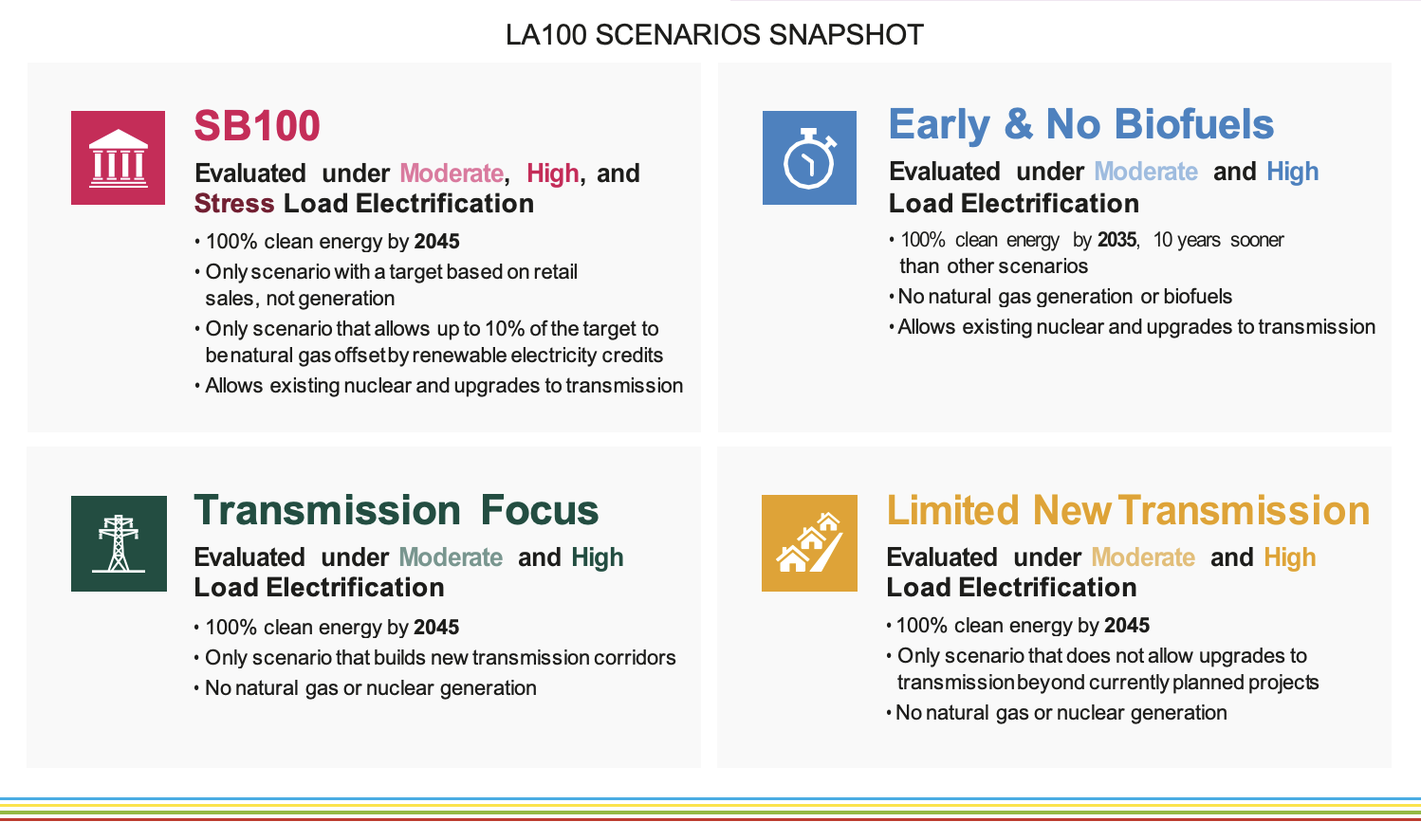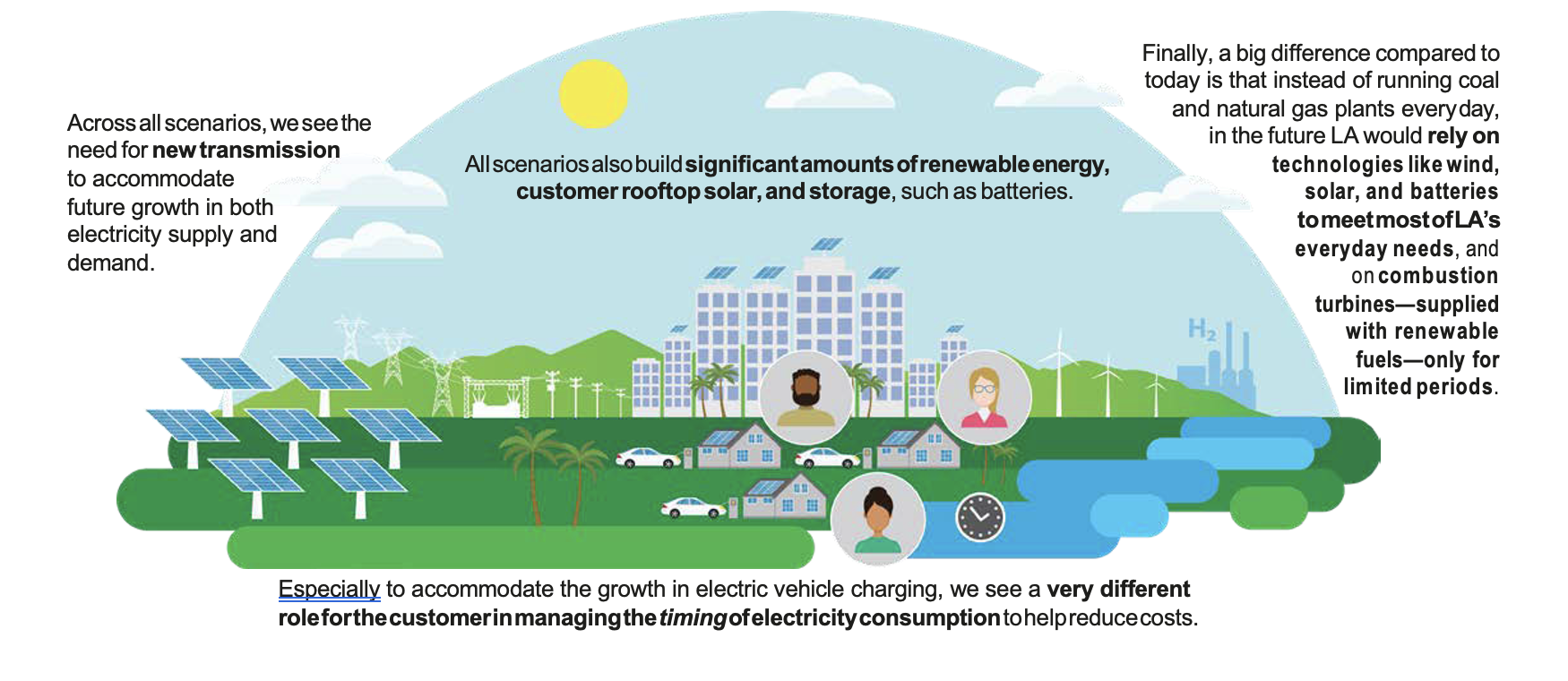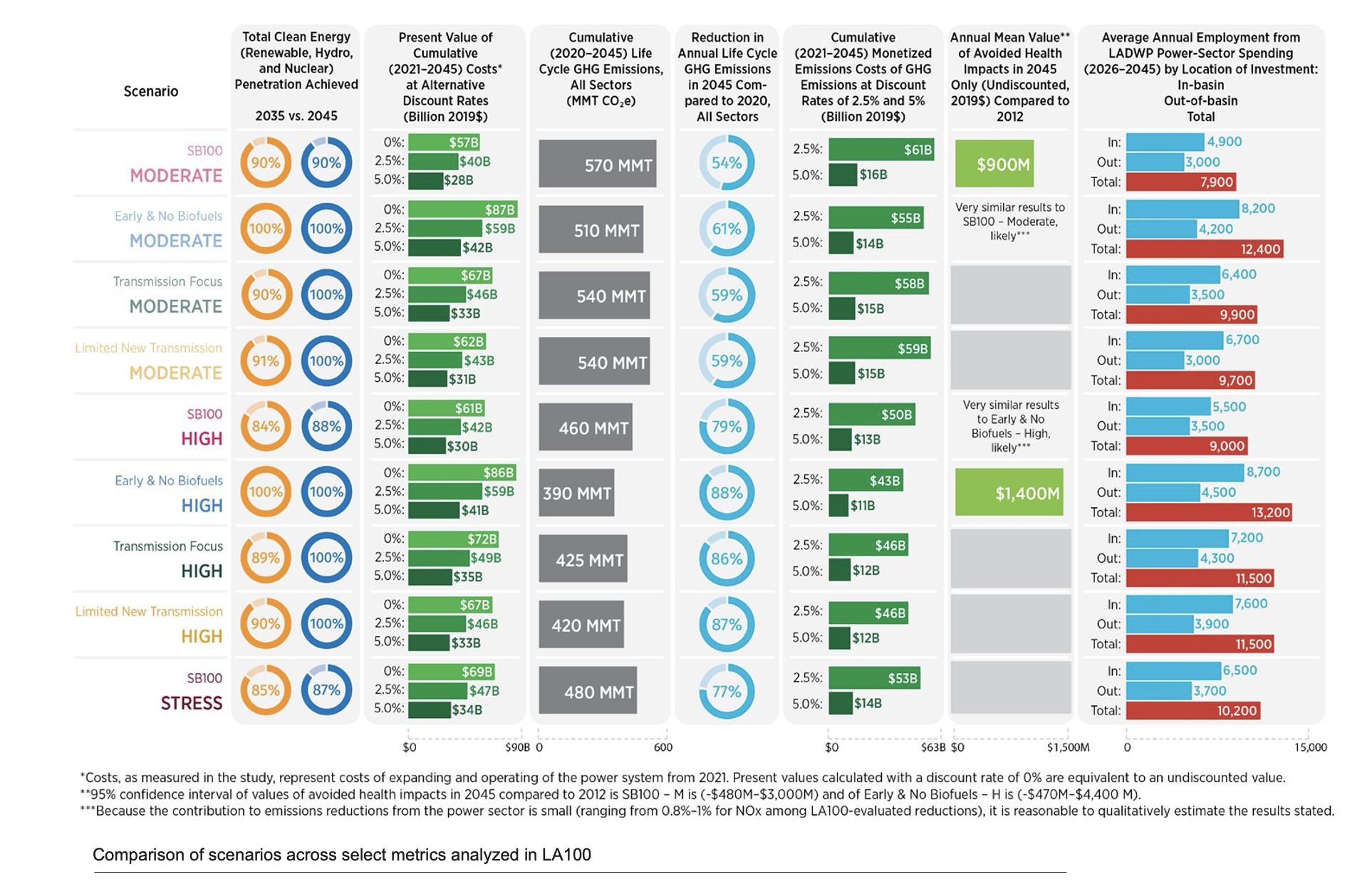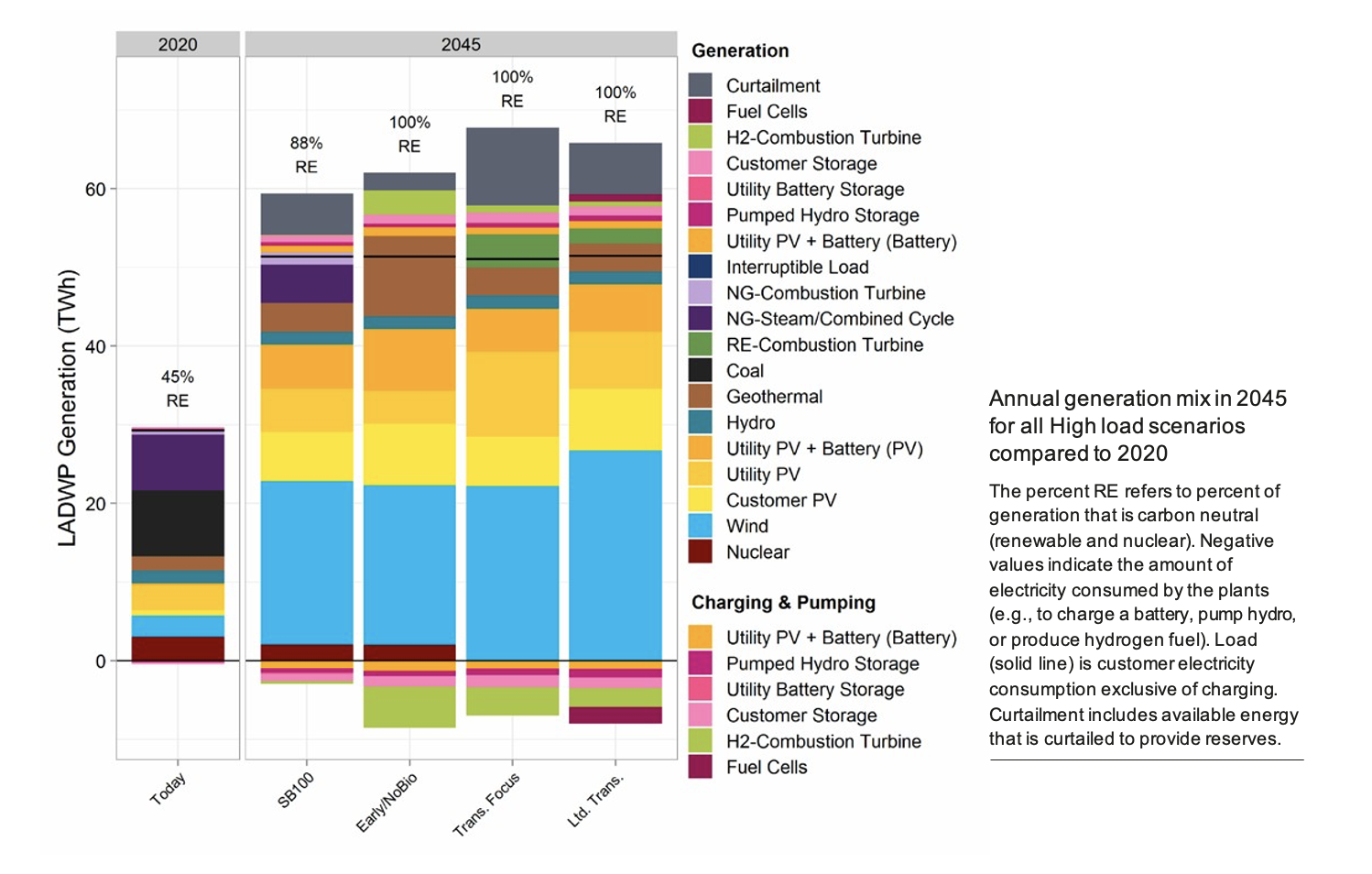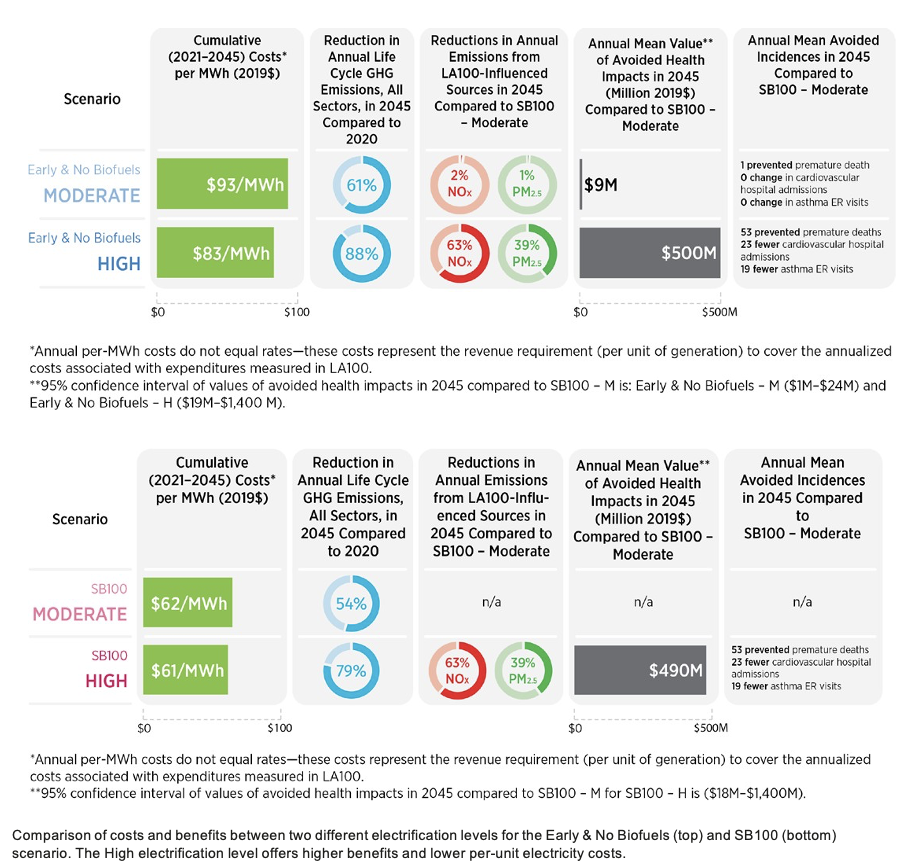To assist the City of Los Angeles in achieving the goals set forth in LA's Green New Deal, the Los Angeles Department of Water & Power commissioned a pioneering analysis by the National Renewable Energy Laboratory (NREL) to study the feasibility and investment pathways for reaching these goals, along with implications for jobs, electricity rates, the environment, and environmental justice. Here, Lauren Faber O'Connor, City of LA CSO, offers words to introduce how the study’s results show that LA's goal of reliable, 100% renewable electricity by 2045—or even 2035—is achievable and will entail rapid deployment of wind, solar, and storage technologies this decade. TPR shares this interactive summary of the study's key findings by energy scenario; please find the executive summary and full report online, here.
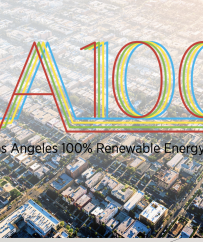
"L.A. just made history by leading the way to a clean energy future. The findings of the groundbreaking LA100 study illuminate the pathways by which the largest municipal utility in the country can achieve a 100% renewable energy grid while maintaining reliability and prioritizing equity and affordability for customers. Mayor Garcetti has set clear and ambitious goals for the L.A. Department of Water and Power who has completed the three-year LA100 study in partnership with the U.S. Department of Energy’s National Renewable Energy Laboratory and an advisory group of L.A.-based stakeholders. This groundbreaking study is the first of its kind in the country, if not the world, owing to its level of detail and comprehensiveness, as well as focus on inclusive process. Important findings include a) 100% renewable energy is reliable and achievable; and b) higher rates of electrification for buildings and transportation result in lower costs and bigger health improvements. Importantly, the study does not provide recommendations on which pathway to select but rather sets forth the data by which a series of decisions can be made by LADWP in conjunction with stakeholders as they conduct strategic long term planning throughout the year. The study paves the way for other jurisdictions to reach for the 100% renewable energy goal that underpins carbon neutrality and the transition to a clean energy future for all."—Lauren Faber O'Connor
This fact sheet describes high-level findings from the Los Angeles 100% Renewable Energy Study (LA100), a partnership between the Los Angeles Department of Water and Power (LADWP) and the National Renewable Energy Laboratory (NREL) to analyze potential pathways LA can take to achieve a 100% clean energy future. Find additional background and detail in the LA100 Executive Summary: nrel.gov/docs/fy21osti/79444-ES.pdf
Exploring Possible Futures: LA100 Scenarios
NREL worked with the study’s LA-based Advisory Group to develop four scenarios to evaluate pathways to 100% renewable energy for Los Angeles. Each scenario explores one possible pathway toward a clean energy future. All scenarios have the same end goal—100% renewable energy— but how the goal is achieved (and what qualifies as a renewable or clean technology) varies across the scenarios.
Each scenario is evaluated under different projections of future customer electricity demand, reflecting differences among energy efficiency investments, electrification of buildings and transportation, and flexibility of this cus- tomer demand
• The Moderate projection assumes moderate (above- code) improvements to energy efficiency and moderate electricity demand growth due to electrification of consumer products like cars and stoves, and moderate improvements to energy efficiency.
• The High projection assumes a bigger effort to decarbonize buildings and transportation. This projection assumes that almost all appliances and heating and other equipment in buildings switch from natural gas
to electric, and that 80% of passenger cars on the road by 2045 are plug-in electric, and that 12% of demand is shiftable. The high energy efficiency target means that customers buy almost exclusively the most efficient building materials and appliances.
• The Stress projection represents all the electrification of the High projection, but with lower efficiency and demand response improvements compared to Moderate, which would otherwise help manage the electrification- driven growth in electricity demand
Looking across the scenarios, the LA100 study reveals key insights about what a high-renewable-energy future could look like in LA—and beyond.
• On the road to achieving 100% renewables by 2045, all LA100 scenarios include significant deployment of renewable and zero-carbon energy by 2035, accounting for 84%–100% of energy and a decline of 76%–100% greenhouse gas (GHG) emissions from power plant operations in 2035 compared to 2020, depending on the scenario. Each of the scenarios builds new wind, solar, batteries, and transmission, coupled with operational practices that make more efficient use of these investments.
• By 2045, electricity demand (both annual consumption and peak demand) is likely to grow. High levels of energy efficiency can offset this growth in the buildings sector due to hotter climate, population growth, and
electrification. It is the electrification of the transportation sector that propels overall growth in electricity demand.
• Also by 2045, with the incentives evaluated in the study, customers are likely to drive significant growth in rooftop solar: 3–4 gigawatts (GW), including up to a third of customers in existing single-family homes, based on favorable economics to the customer. LADWP might also deploy an additional 300–1,000 megawatts (MW) of non-rooftop, in-basin solar. The distribution grid can manage this growth in local solar—along with the projected growth in electricity demand. While almost all parts of the distribution grid will need some upgrades, the LA100 study estimates that, after correcting deferred maintenance on the existing system, a modest number of equipment upgrades would be sufficient to manage growth in demand and local solar. These distribution upgrade costs represent a small fraction of the total cost of the clean energy transition.
• Electrification of vehicles and buildings leads to substantial improvements in air quality and associated benefits to health—widespread across both disadvantaged and non-disadvantaged communities. LA100’s results indicate that realizing these health benefits is principally a matter of achieving high energy efficiency and electrification, independent of any particular renewable energy pathway for the power sector.
• Also regardless of the pathway, economic impacts to the city of the 100% renewable energy transition are projected to be small relative to the overall size
of LA’s economy—so while the transition could create thousands of clean energy jobs annually, the clean energy investments alone are not anticipated to notably impact LA’s economy overall.
Major Trends Across All Pathways to 100%
1. Reliable, 100% renewable electricity is achievable— and, if coupled with electrification of other sectors, provides significant greenhouse gas, air quality, and public health benefits.
- While achieving a reliable, 100% renewable electricity power system is a significant undertaking requiring substantial investments, the LA100 analysis identifies multiple pathways to get there.
- Wind and solar resources—enabled by storage—are fundamental to providing the majority of energy required to meet future load: 69%–87% depending on the scenario.
- New in-basin, renewable firm capacity—resources that use renewably produced and storable fuels, can come online within minutes, and can run for hours to days—will become a key element of maintaining reliability (represented in the figure below as hydrogen- and renewably [RE]-fueled combustion turbines and fuel cells).
- Decarbonizing the power sector through renewable deployment helps create the enabling conditions for decarbonization of the buildings and transportation sectors through electrification. While the power sector itself contributes few non-GHG air pollutant emissions in a 100% renewable future, the electrification of combustion sources in other sectors enables more significant emissions reductions, and thus improved health for Los Angeles residents.
2. All communities will share in the benefits of the clean energy transition—but improving equity in participation and outcomes will require intentionally designed policies and programs.
- Disadvantaged communities (as defined by CalEnviroScreen scores) could expect to see many benefits in a clean energy transition, including reduced local and regional air pollution, improved indoor air quality from electrification, reduced vulnerability to climate change and improved health outcomes.
- Ensuring prioritization of these neighborhoods, however, is not an inevitable result of the power- system transition. A just, equitable clean energy future would require intentionally designed decision-making processes and policies/programs that prioritize these communities (see the text box below).
- Using SB100 – Moderate as a reference scenario, the net impact to employment within the city (reflecting combined positive and negative impacts of economic activity measured in LA100, from 2026 to 2045) ranges from a low of 3,600 fewer jobs annually under the Early & No Biofuels – Moderate scenario to 4,700 additional jobs under the SB100 – Stress scenario. While there may be slight positive or negative impacts, these changes are small in relationship to the 3.9 million jobs and $200 billion in annual output of LA’s economy as a whole, so they have an almost negligible impact.
- Specific to jobs associated with LADWP expenditures as measured in LA100, both in and outside of the LA Basin, higher expenditures on new infrastructure and operations of both existing and new infrastructure (exclusive of the distribution grid) correlate with higher numbers of jobs. The number of gross annual jobs (onsite and ripple effect) supported by these expenditures ranges from an average of 7,900 jobs per year in SB100 – Moderate to 13,200 jobs per year in Early & No Biofuels – High.
3. Net economic assessment shows that achieving the LA100 scenarios will not affect LA’s overall economy in any meaningful manner.
4. LA can get started now, with many no-regrets options that achieve significant emissions reduction (76%–99%) by 2030.
- The LA100 study finds many no-regrets options. On the customer side, the study shows significant benefits from electrification in terms of improving GHG emissions, air quality, and health, and emphasizes the critical role of customer demand flexibility to reduce per-unit electricity costs and contribute to reliability.
- When it comes to the LADWP power system, the no-regrets options include new wind, solar, batteries, and transmission—deployed in or out of the LA Basin, and coupled with smart-grid operational practices that make more efficient use of these investments. LADWP can also address existing distribution maintenance needs to enable changes on the customer side, which were assumed to have already occurred as the starting point for LA100.
Key Distinctions Between Pathways to 100%
1. The LA100 scenarios show similar cost increases until approximately 80%–90% renewable energy. The pathways diverge with differences in the technologies deployed to meet the last
10%–20% of energy demand that cannot be easily served by wind, solar, and conventional storage technologies—and to maintain reliability in the face of extreme events.
- In-basin renewable capacity that can come online within minutes and run for days serves a critical role: it provides energy during periods of lower wind and solar generation, extremely high demand, and unplanned events like transmission line outages.
- Today, the cheapest option for this type of peaking capacity is a storable renewable fuel used in a combustion turbine. Biofuels are commercially available today and could serve as a transition fuel until commercially available, electricity-derived fuels become more widespread.
- If the City of LA does not want to use biofuels, LADWP can produce its own clean fuel in the form of hydrogen (produced from renewable electricity).
° This option is not yet commercially available at scale, so building the necessary infrastructure could represent a significant portion of total costs associated with the clean energy transition.
° In the Early & No Biofuels scenario, hydrogen technology represents a 20+% increase in cumulative (2021–2045) costs compared to cases that allow biofuels.
- The resources used to help meet this last 10% and maintain reliability can produce local air emissions, particularly when based on combustion generation.
- However, even accounting for future growth in energy demand, these new resources would be used much less often than current natural-gas plants, resulting in lower emissions—both in the power sector and economy-wide.
2. The combination of higher energy efficiency, electrification, and demand flexibility, while associated with increased total costs, offers both greater benefits and reduced per-unit electricity costs compared to alternative scenarios.
- While LA100 does not represent a complete analysis of tradeoffs (e.g., it does not address costs of demand-side equipment, employment benefits from energy efficiency, and impact to overall energy expenditures, among others), the benefits as measured within the study are significant. For example, comparing a scenario with Moderate and High electrification levels, while the High electrification version has higher total costs, it offers lower per-unit costs, higher GHG and air pollutant emissions reductions, and higher public health benefits (see the figures on the next page).
- In addition, comparing SB100 – Stress to SB100 – High shows the value of energy efficiency and demand flexibility (as the scenarios are otherwise the same). SB100 – Stress has an 8.5% higher annual electricity consumption and 17% higher peak demand compared to SB100 – High. The combination of efficiency and demand flexibility assumed in the High version reduces the cumulative (2021–2045) costs of that scenario by 13%.
1. Accelerating the target year to 2035 increases both costs and benefits.
- All else equal, an earlier target year means LADWP must make the necessary investments to achieve 100% renewable electricity more quickly. This results in earlier accumulation of debt, ultimately leading
to greater costs over the timeframe of this study (2021–2045).
- However, benefits also accrue more quickly, though not necessarily at the same rate as costs. The earlier LADWP achieves a zero-GHG-emission or 100% renewable system, the earlier the avoided emissions accumulate. Reducing emissions earlier has value in terms of reducing the magnitude of the effects of climate change. Similarly, new renewable energy jobs accrue more quickly.
- The Early & No Biofuels scenario accumulates both the costs (from annualized payments for renewable technologies) and benefits (GHG emissions, renewable energy jobs) of this transition due to the 10-year head start.
- If the earlier target is pursued, success would also require an accelerated schedule for renewable energy procurement, permitting, siting, and workforce training, among other activities that are outside the scope of the study but are essential components of implementation.
- The costs, GHG emissions, air quality, and public health trajectories across scenarios (within any given electrification level) are similar until each scenario reaches approximately 90% renewable and zero- carbon electricity. After 90%, the costs diverge for different scenarios, but the overall benefits plateau.
- SB100 remains around 90% renewable and zero- carbon electricity through 2045 due to how this scenario is defined. But all the other scenarios move from 90% to 100% renewable electricity by 2045—and they exhibit sharp increases in costs in the last 10%.
- The additional benefits of restricting technology eligibility in terms of air quality and public health, as measured in the selected scenarios analyzed in
2. Technology restrictions result in higher costs when it comes to meeting the last 10%–20% of energy demand—but almost no additional air quality or public health benefits.
- The costs, GHG emissions, air quality, and public health trajectories across scenarios (within any given electrification level) are similar until each scenario reaches approximately 90% renewable and zero- carbon electricity. After 90%, the costs diverge for different scenarios, but the overall benefits plateau.
- SB100 remains around 90% renewable and zero- carbon electricity through 2045 due to how this scenario is defined. But all the other scenarios move from 90% to 100% renewable electricity by 2045—and they exhibit sharp increases in costs in the last 10%.
- The additional benefits of restricting technology eligibility in terms of air quality and public health, as measured in the selected scenarios analyzed in the study, are minimal when electrification levels areconstant because natural gas consumption acrossall scenarios is significantly reduced or eliminated compared to today. Because changes to the power sector only contribute 0.8%–1% of the NOx emissions reductions among LA100 scenarios compared to 2012, and 10%–18% of the particulate-matter emission reductions, it is clear that changes to energy efficiency and electrification levels (for vehicles, buildings, and the Ports of Los Angeles and Long Beach) are the predominant cause of health benefits.
Looking Ahead: Addressing Uncertainty, Prioritizing Future Decisions
1. Identifying alternative options for firm, in-basin capacity likely represents the largest opportunity to reduce the costs of the transition and points
to the highest priorities for R&D: hydrogen and extended demand response.
- All LA100 scenarios build in-basin combustion-based resources to help meet the last 10%–20% of electricity demand that is not easily met by low-cost wind, solar, and batteries. The timing of building these new resources can be cost-effectively delayed somewhat with a combination of energy efficiency, local solar and storage, new transmission, and technologies and techniques to increase the capacity of existing, in-basin transmission. But delays in deploying these other options could accelerate the need for new in-basin resources.
- The fuel for new in-basin resources varies by scenario. Several scenarios use biofuels, which are commercially available and serve as a net-zero-carbon transition fuel while technologies such as hydrogen-based fuels mature.
- Alternatives to biofuels include renewable electricity- derived hydrogen fuel, or hydrogen derivatives, such as synthetic methane or ammonia. There is considerable uncertainty regarding hydrogen’s long-term cost and commercial availability, as well as generator modifications needed to use these fuels. There is also uncertainty as to how long it will take to develop infrastructure for transportation and storage.
To reduce hydrogen costs, the City of LA could partner with industry as part of economy-wide decarbonization where hydrogen-derived fuels are used to power industry, non-electrified transportation, and serve as feedstocks for chemicals and materials that currently rely on fossil fuels.
- Across the scenarios, allowing fuel flexibility (biofuels inclusive) allows LADWP to start now without committing to hydrogen infrastructure. Allowing renewable electricity credits (RECs) (to continue limited use of natural gas) could mitigate risk; limiting use of RECs to a few percent could provide the needed reliability benefits and still provide nearly all the GHG, air quality, and public health benefits associated with the transition to 100% renewable electricity.
- In addition to fuel flexibility and RECs to mitigate uncertainty in the use of hydrogen and biofuels, one alternative yet to be deployed and tested at scale is multi-day (or extended) demand response. Such a program could be initiated now to enable more rapid roll-out should the City of LA proceed with biofuel or hydrogen options and find those paths infeasible or cost-prohibitive.
- A multi-day demand response program would require a detailed analysis of the customer base to identify customers with flexible loads, and the necessary compensation needed to reduce these loads for extended periods. Exploring this option would likely require pilot programs and new rate designs that compensate customers for reduced energy consumption, as these types of programs do not exist at scale in the United States outside of very large industrial customers.
2. What if LA wants to pursue an earlier target?
- The LA100 study did not evaluate achieving 100% renewable energy prior to 2035. However, in 2030 the scenarios achieve a decline of 76%–99% GHG emissions from power plant operations compared to 2020, and an overall renewable and zero-carbon energy contribution of 77%–99% of energy, depending on the scenario—so significant progress can be made in the next decade if LA starts now.
- A faster transition to 100% renewables would likely require deployment of technologies at a higher cost, reflecting both technology maturity and commercial availability. The costs could be particularly high for firm capacity resources needed to fully replace natural gas, given the current role of natural gas in responding to extreme events. We assume this complete transition
is feasible by 2035, but we have not evaluated the supply chain and other aspects of feasibility that would be required to effect this change in less than 10 years.
- Availability of this type of firm capacity resource (e.g., hydrogen production, renewably fueled combustion turbines, fuel cells) would benefit greatly from a robust RD&D program at the financial scale of national and international initiatives rather than a single city’s budget.
- Expediting regional transmission development would likely require state- and federal-level support.
- LA100 establishes a methodology that could serve as a foundation for additional and updated analyses that could help reassess costs, benefits, and tradeoffs over time. Continued analyses are needed to understand how to improve implementation, monitor results, and adjust decisions.
2. This study marks an important but not final analysis in LA’s pivot towards a clean and equitable energy future.
- LA100 establishes a methodology that could serve as a foundation for additional and updated analyses that could help reassess costs, benefits, and tradeoffs over time. Continued analyses are needed to understand how to improve implementation, monitor results, and adjust decisions
- In particular, using current-generation, forward-looking models to anticipate implications for environmental justice does not capture real-world experiences and barriers to adoption. Therefore, effectively prioritizing environmental justice in implementation, per the City Council motion, would require ongoing monitoring and adjustments.
- In addition, aspects related to customer demand (efficiency, electrification, demand response, and customer solar and storage) also represent high- priority areas for ongoing analyses. The changes on the demand side occur, to a large degree, outside of LADWP’s immediate control and planning, but can be substantially impacted by rate structures, incentives, or local policies, and have significant potential to affect the costs and benefits of the 100% renewable transition
Additional results by scenario and topic, links to download each chapter of the full report, a glossary of terms, and an interactive data viewer can be found on the study website at: maps.nrel.gov/la100
- Log in to post comments



